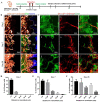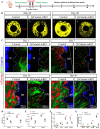Alveolar Bone Marrow Gli1+ Stem Cells Support Implant Osseointegration
- PMID: 34009063
- PMCID: PMC8721727
- DOI: 10.1177/00220345211013722
Alveolar Bone Marrow Gli1+ Stem Cells Support Implant Osseointegration
Abstract
Osseointegration is the key issue for implant success. The in vivo properties of cell populations driving the osseointegration process have remained largely unknown. In the current study, using tissue clearing-based 3-dimensional imaging and transgenic mouse model-based lineage tracing methods, we identified Gli1+ cells within alveolar bone marrow and their progeny as the cell population participating in extraction socket healing and implant osseointegration. These Gli1+ cells are surrounding blood vessels and do not express lineage differentiation markers. After tooth extraction and delayed placement of a dental implant, Gli1+ cells were activated into proliferation, and their descendants contributed significantly to new bone formation. Ablation of Gli1+ cells severely compromised the healing and osseointegration processes. Blockage of canonical Wnt signaling resulted in impaired recruitment of Gli1+ cells and compromised bone healing surrounding implants. Collectively, these findings demonstrate that Gli1+ cells surrounding alveolar bone marrow vasculature are stem cells supporting dental implant osseointegration. Canonical Wnt signal plays critical roles in regulating Gli1+ stem cells.
Keywords: Wnt signaling pathway; alveolar bone; bone-implant interface; dental implantation; hedgehogs; periodontium.
Conflict of interest statement
Figures





Similar articles
-
In vivo monitoring of the bone healing process around different titanium alloy implant surfaces placed into fresh extraction sockets.J Dent. 2012 Apr;40(4):338-46. doi: 10.1016/j.jdent.2012.01.010. Epub 2012 Jan 28. J Dent. 2012. PMID: 22307025
-
A randomized clinical trial to evaluate and compare implants placed in augmented versus non-augmented extraction sockets: 3-year results.J Periodontol. 2012 Jul;83(7):836-46. doi: 10.1902/jop.2011.110205. Epub 2011 Dec 5. J Periodontol. 2012. PMID: 22141358 Clinical Trial.
-
Socket Preparation for Delayed Implant Placement Using a Mineralized Cancellous Allograft.Compend Contin Educ Dent. 2021 Apr;42(4):f1-f4. Compend Contin Educ Dent. 2021. PMID: 33961749 Review.
-
Bone formation following implantation of bone biomaterials into extraction sites.J Periodontol. 2008 Jun;79(6):1108-15. doi: 10.1902/jop.2008.070476. J Periodontol. 2008. PMID: 18533791 Clinical Trial.
-
Immediate or early placement of implants following tooth extraction: review of biologic basis, clinical procedures, and outcomes.Int J Oral Maxillofac Implants. 2004;19 Suppl:12-25. Int J Oral Maxillofac Implants. 2004. PMID: 15635942 Review.
Cited by
-
The Role of Gli1+ Mesenchymal Stem Cells in Osteogenesis of Craniofacial Bone.Biomolecules. 2023 Sep 5;13(9):1351. doi: 10.3390/biom13091351. Biomolecules. 2023. PMID: 37759749 Free PMC article. Review.
-
Differentiation potential of periodontal Col1+ cells under orthodontic force.Mechanobiol Med. 2023 Oct 29;2(1):100026. doi: 10.1016/j.mbm.2023.100026. eCollection 2024 Mar. Mechanobiol Med. 2023. PMID: 40458548 Free PMC article.
-
The effect of implants loaded with stem cells from human exfoliated deciduous teeth on early osseointegration in a canine model.BMC Oral Health. 2022 Jun 17;22(1):238. doi: 10.1186/s12903-022-02264-5. BMC Oral Health. 2022. PMID: 35715777 Free PMC article.
-
Subset of the periodontal ligament expressed leptin receptor contributes to part of hard tissue-forming cells.Sci Rep. 2023 Mar 1;13(1):3442. doi: 10.1038/s41598-023-30446-w. Sci Rep. 2023. PMID: 36859576 Free PMC article.
-
Enhancer-driven Shh signaling promotes glia-to-mesenchyme transition during bone repair.Bone Res. 2025 Jan 26;13(1):16. doi: 10.1038/s41413-024-00396-8. Bone Res. 2025. PMID: 39865079 Free PMC article.
References
-
- Branemark PI, Adell R, Breine U, Hansson BO, Lindstrom J, Ohlsson A. 1969. Intra-osseous anchorage of dental prostheses. I. Experimental studies. Scand J Plast Reconstr Surg. 3(2):81–100. - PubMed
-
- Buser D, Sennerby L, De Bruyn H. 2017. Modern implant dentistry based on osseointegration: 50 years of progress, current trends and open questions. Periodontol; 2000. 73(1):7–21. - PubMed
-
- Calvo-Guirado JL, Ortiz-Ruiz AJ, Negri B, Lopez-Mari L, Rodriguez-Barba C, Schlottig F. 2010. Histological and histomorphometric evaluation of immediate implant placement on a dog model with a new implant surface treatment. Clin Oral Implants Res. 21(3):308–315. - PubMed
-
- Canellas JVDS, Medeiros PJD, Figueredo CMDS, Fischer RG, Ritto FG. 2019. Which is the best choice after tooth extraction, immediate implant placement or delayed placement with alveolar ridge preservation? A systematic review and meta-analysis. J Craniomaxillofac Surg. 47(11):1793–1802. - PubMed
Publication types
MeSH terms
Substances
Grants and funding
LinkOut - more resources
Full Text Sources
Other Literature Sources

